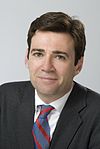Labour Party (UK) leadership election, 2010
|
|
|||||||||||||||||||||||||||||||||
|---|---|---|---|---|---|---|---|---|---|---|---|---|---|---|---|---|---|---|---|---|---|---|---|---|---|---|---|---|---|---|---|---|---|
|
|||||||||||||||||||||||||||||||||
| Turnout | 127,330 (71.7%) |
||||||||||||||||||||||||||||||||
|
|||||||||||||||||||||||||||||||||
|
|||||||||||||||||||||||||||||||||
Harriet Harman (pro tempore); previously Gordon Brown
The 2010 Labour Party leadership election was triggered by a general election which resulted in a hung parliament. On 10 May, Gordon Brown resigned as Leader of the Labour Party. The following day, he stepped down as Prime Minister. The National Executive Committee decided the timetable for the election the result of which would be announced at the annual party conference. On 25 September, Ed Miliband became the new Leader of the Labour Party.
The rules of the Labour Party stated in 2010 that "each nomination [for leader] must be supported by 12.5 per cent of the Commons members of the Parliamentary Labour Party." As the number of Labour MPs was 257 (the 258 returned at the general election minus Eric Illsley, who had been suspended from the Parliamentary Labour Party) 33 MPs needed to support any nomination. Nominations opened on 24 May and closed on 27 May, but the deadline was extended to 9 June after complaints from John McDonnell, Diane Abbott, and Ed Miliband that the short deadline had provided insufficient time to secure the 33 nominations from MPs needed for inclusion on the ballot. The ballot took place between 1 and 22 September, and the results were announced on the first day of the party's conference in Manchester, 25 September. There were three distinct , the electors of which cast their votes on a "one member, one vote" basis in each applicable category:
...
Wikipedia





